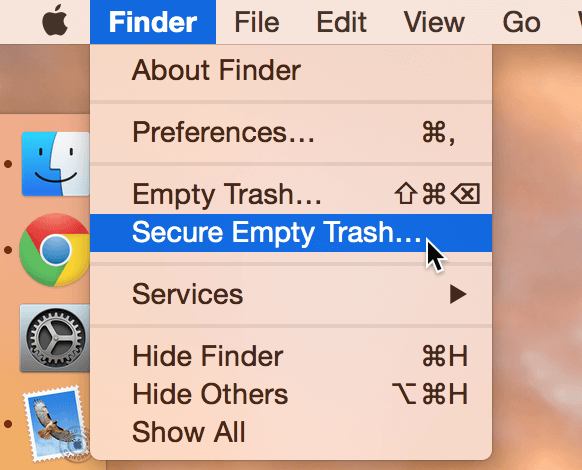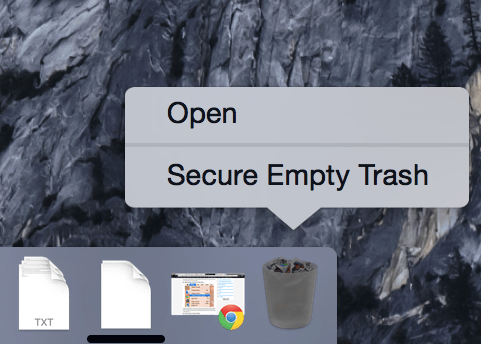Secure trash deletion for mac free download - Trash It, Trash Compactor, AppleMacSoft Empty Trash, and many more programs. That can be done with the help of a secure file eraser. What Is a Secure File Eraser? Much like tossing a physical document into a trash bin doesn’t permanently destroy it, it’s the same for a digital file on your Mac — deleting it by dragging-and-dropping to Trash leaves it available for recovery.
Macs have a reputation of lasting longer than others. You might think of replacing mac not because of reduced performance but for upgraded operating system. However, when you are replacing mac you’d certainly delete your files and folders. You think deleting files will ensure their safety, then you are definitely mistaken. You need to secure empty trash on mac before selling it. This will ensure that anyone cannot retrieve your files and misuse them.
What Is Secure Empty Trash?
When we delete files from trash, we are just emptying it. There is no surety that it has been erased and gone for good! With use of efficient recovery software, all of it can be recovered. Simply put, any data on your mac can be recovered unless it has been overwritten. This is the reason why you need secure empty trash on mac. By securing your mac, you are basically making them unrecoverable by including a series of zeros and ones(Binary combination) over deleted files. This feature was used to be available on OS X Yosemite and earlier. However, this was discontinued as the later as it didn’t work on flash drives.
Secure Empty Trash (hold down the Command key while emptying the Trash) is no longer available in OS X El Capitan. Secure Empty Trash wouldn’t just delete the file’s index, but also would.
- How to Secure Empty Trash Quickly in Mac OS X with a Right-Click: Mac OS X makes it easier than.
- This is an empty trash Mac shortcut that will ensure that all feature deleted files get permanently and securely erased. Part 2: How to Solve When Mac Trash Won’t Empty It is at those times when you can’t empty trash on Mac that panic slowly starts to trip in.
How To Secure Empty Trash On OS X Yosemite and Earlier?
If you are someone who is still using OS X Yosemite and earlier, then you can easily use built in features to secure empty trash on Mac. All you have to do is follow the steps given below and the rest will be taken care of !
Drag files to trash and then select Finder. Furthermore, from the drop down list, choose “Secure Empty Trash.” This will automatically secure your empty trash on Mac. also, remember that when you secure empty trash, it takes a bit longer than just deleting them.
Securely Empty Trash on OX El Capitan with Terminal
Since the feature of securely emptying trash was removed from this version onwards, you’ll have to do so via terminal commands. Follow the steps given below to do the same!
- Open terminal.
- Enter srm -v{space}. Make sure you enter space and do not hit enter.
- Drag file from finder to terminal.
- Your command will be modified by doing this and then hit enter.
- This will secure the deleted files in trash.
Secure Empty Trash mac Sierra
The option of securing deleted files via command mode was removed for macOS Sierra users. If you are someone who needs it then we’d recommend you to encrypt the entire disk with FileVault. Also, there are certain third-party tools with which deleting your files securely is possible. For this, TuneupMyMac is the best available option. Read further and get to know about it in detail.
TuneupMyMac
This is one of the best tools available for optimizing your Mac. You can easily enhance performance of your system via advanced and powerful features included in this. Yes, manual decluttering is an option, but consumes too much time and efforts. For this, we need one full-fledged tool that has optimization power like no other, TuneupMyMac. It not only secures empty trash but is capable of doing several other things.
Secure Deleted Files and Folders
It has a shredder because of which the files and folders deleted cannot be retrieved by any third party. This way, you privacy is never at stake and the deleted files remain out of reach for everyone.
There are several other features in tool which makes it an optimal choice for optimizing the performance of your Mac and secure empty trash. Give this one a try and you’ll definitely find it worthy.
Responses

That little silver trash can on your Mac’s desktop represents an invisible Mac trash folder. Technically, items in your trash are still on your Mac, as you can drag them right back out. To delete those items, you simply empty the trash. But are they really gone?

In this post, we’ll talk about the difference between “empty trash”, “empty trash securely”, and how to make sure your deleted files are well and truly gone.
And if you'd like your files to completely annihilate, try a Shredder tool in CleanMyMac X. This tool is absolutely free to use.
The difference between Empty Trash and Secure Empty Trash
Secure Trash On Mac
When you empty trash in macOS, the files inside aren’t actually erased. The space they occupied is marked by the system as available for overwriting, but the files themselves remain on your drive until they’re overwritten by something else. This means if someone wanted to recover deleted files with special software, they have a chance to succeed, although it’s a tedious process. This is where the secure empty trash feature comes in.
When you empty trash securely, the system writes a series of ones and zeroes over the file you’ve deleted, making it impossible to recover. This feature was an option in OS X until the release of El Capitan, when Apple removed it.
Secure erase is different for SSD and HDD drives
Before 2012, all MacBooks had HDDs (magnetic drives). Today, the industry standard is SDD and all MacBooks are shipped with those. The old way of 'secure erase' doesn't work for solid state drives. But if you need to make sure the files are 100% gone, still there are ways to do it.
How to secure empty Trash on macOS Catalina
1. Force empty trash using Terminal
Before we begin, a note. You can make a mess of things with Apple’s Terminal. It’s crucial to understand the commands and type them without errors. If you start to sweat a bit just reading this, move on. There are alternatives. Otherwise, here we go.
First, you should enable Terminal as a service in the right-click menu.
- Click on Apple menu > System Preferences > Keyboard.
- Now, choose Services.
- Make sure 'New Terminal at Folder' is ticked.
This command allows to apply Terminal commands to a particular folder. In our case, the Terminal will secure erase the entire folder content.

- Put your undesired documents in a new folder
- Now, right-click this folder to reveal Services.
- Choose New Terminal at Folder
- Enter the final Terminal command
We've come to the final part. Now we need to tell Terminal which files to secure erase from the folder we've just specified.
Paste in the following command into the Terminal window:
rm -P Archive.zip
But replace Archive.zip with the name of YOUR file and its extension — it's the file inside the folder you want to erase.
Click Enter and wait for magic to happen. The file or archive should now be completely and securely erased. Check your folder to see the file gone.
2. Empty trash securely with CleanMyMac X
Fortunately, you can empty trash securely in a click with CleanMyMac X app by MacPaw. Not only does it empty your desktop trash, but it also cleans up all the other trash bins on your Mac, including those most often overlooked. This program is also notarized by Apple.
Multiple trash bins? Yes! For example, Photos has its very own trash. When you delete an image from Apple’s Photos app, it’s actually moved to the Photos trash. You won’t see it in your desktop trash can. The same goes for Mail, Aperture, external drives and more. Even if you forget about theses bins, CleanMyMac does not. So, let’s take a closer look at how you can empty all the trash bins securely with CleanMyMac X.
Once CleanMyMac is running, click the “Trash Bins” icon on the left hand side, and then hit Scan. CleanMyMac X browses all the trash bins on your drive and in your apps, finds everything that can be securely removed, and shows you a list of what it has found.
After completing a scan, you can browse what’s been found, and easily de-select any file you’d rather keep. For a more detailed view, click Review Files to see what’s been identified in each individual trash bin. If you’d like to inspect a file itself, just hover your cursor over its name and then click the magnifying glass icon to open that item’s enclosing folder.
Finally, we’ve been talking about securely removing files once and for all, so let’s do that with CleanMyMac X.
Even though Secure Empty Trash is no longer a native function in OS X El Capitan, you can still empty your Mac’s trash securely with CleanMyMac X. Try CleanMyMac and be sure the files you delete are really gone.
A free Shredder tool in CleanMyMac X
Secure deletion means replacing the original file with random sets of zeroes and ones. That prevents anyone from recovering the file. That's what digital shredding does. It removes the file and overwrites it afterwards. Such free tool is available in CleanMyMac X.
In CleanMyMac X, choose Shredder tab at the bottom of the sidebar.
Now, select files you want to erase.
Be careful, you can't un-shred an important file.
3. Delete files straightforwardly
Mac Trash Settings
Finally, there is a way to delete files immediately, without putting them into Trash first. This is not a secure deletion (doesn't overwrite files) — but rather analogous to emptying the Trash.
1. Highlight a file you'd like to delete.
2. Click File in the top menu.
3. Hold down the Option key.
Immediately, you'll see an option for 'Delete immediately' in the menu.
Use this at your own risk.
Secure Empty Trash Mac Mojave
Okay. Now you know how to securely erase files on macOS. And, hopefully, your Terminal experience hasn't been too stressful. For easier options, there are many free tools you can use. One of those is CleanMyMac X's Shredder.
Secure Empty Trash Mac Os
These might also interest you:

